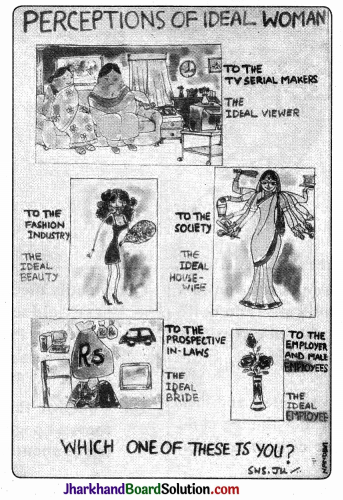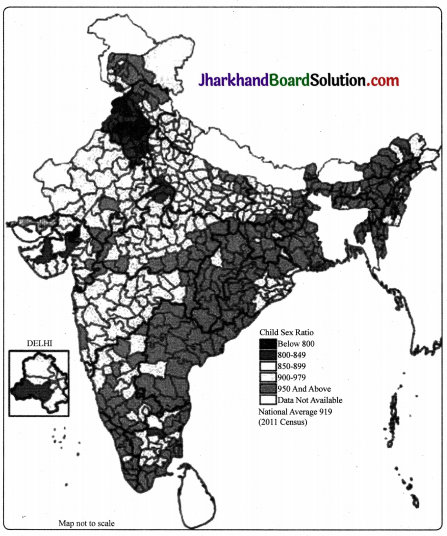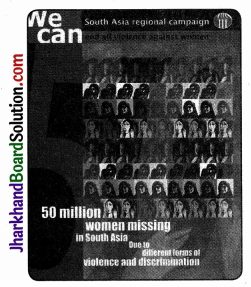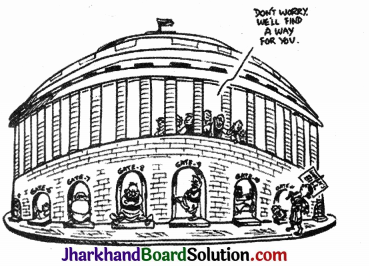JAC Board Class 10th Social Science Important Questions Civics Chapter 4 Gender Religion and Caste
Multiple Choice Questions
Question 1.
What did Gandhiji mean when he said that religion and politics can never be separated?
(a) Effect of Hinduism on politics is more
(b) Effect of Islam on politics is more
(c) Need moral values in politics
(d) None of these
Answer:
(c) Need moral values in politics
![]()
Question 2.
In some places in India, by how much the child sex ratio has fallen to as low as?
(a) 927
(b) 840
(c) 820
(d) 800
Answer:
(d) 800
Question 3.
Which of these countries has no official state religion?
(a) Sri Lanka
(b) Pakistan
(c) England
(d) All of these
Answer:
(d) All of these
Question 4.
The percentage of elected women members in the Lok Sabha has never reached what per cent of its total strength?
(a) 25%
(b) 15%
(c) 10%
(d) 5%
Answer:
(c) 10%
Question 5.
Caste system in modern India has undergone with which great changes?
(a) Fundamental
(b) Socio – economic
(c) Cultural
(d) Professional
Answer:
(b) Socio – economic
Question 6.
What is leading to the breakdown of caste hierarchy?
(a) Large – scale urbanisation
(b) Growth of literacy and education
(c) Occupational mobility
(d) All of the above
Answer:
(d) All of the above
![]()
Question 7.
What is the exact ratio of scheduled castes and scheduled tribes in 2001?
(a) Scheduled castes constitute 17.8% and scheduled tribes 9.2%.
(b) Scheduled castes constitute 20.4% and scheduled tribes 8.2%.
(c) Scheduled castes constitute 15.6% and scheduled tribes 7.8%.
(d) Scheduled castes constitute 16.2% and scheduled tribes 8.2%.
Answer:
(d) Scheduled castes constitute 16.2% and scheduled tribes 8.2%.
Question 8.
Which of these is true about the most ugly form of communalism?
(a) Communal violence
(b) Riots
(c) Massacre
(d) All the above
Answer:
(d) All the above
Question 9.
What is meant by ‘Communal Politics’?
(a) Participation of different communities in politics
(b) When state power is used to establish domination of one religious group over the rest
(c) Communist type of government
(d) All of the above
Answer:
(b) When state power is used to establish domination of one religious group over the rest
Question 10.
Which of these matters deal with the ‘Family Laws’?
(a) Marriage and divorce
(b) Adoption
(c) Inheritance
(d) All of these
Answer:
(d) All of these
Very Shortanswer Type Questions
Question 1.
What is sexual division of labour?
Answer:
A system in which all work inside the home is either done by the women of the family, or organised by them through the domestic helpers.
Question 2.
What do you mean by Feminist?
Answer:
A woman or a man who believes in equal rights and opportunities for women and men is called feminist.
Question 3.
Define patriarchy.
Answer:
Patriarchy literally mean rule by father. This concept is used to refer to a system that values men more and gives them power oyer women.
![]()
Question 4.
What are family laws?
Answer:
Those laws that deal with family related matters such as marriage, divorce, adoption, inheritance, etc. In our country, different family laws apply to followers of different religions.
Question 5.
What is urbanisation?
Answer:
Urbanisation is the shift of population from rural areas to urban areas.
Question 6.
What is occupational mobility?
Answer:
Occupational mobility is the shift from one occupation to another, usually when a new generation takes up occupations other than those practised by their ancestors.
Question 7.
What do you mean by caste hierarchy?
Answer:
Caste hierarchy is a ladder like formation in which all the caste groups are placed from the ‘highest’ to the ‘lowest’ castes.
Question 8.
What helped to improve women’s role in public life?
Answer:
Political expression of gender division and political mobilization throughout the world on this question, helped to improve women’s role in public life.
Question 9.
Name few countries where participation of women in public life is very high.
Answer:
In Scandinavian countries such as Sweden, Norway and Finland, the participation of women in public life is very high.
![]()
Question 10.
Why did the makers of our Constitution choose India to be a secular state?
Answer:
Communalism was and continues to be one of the major challenges to democracy in our country. The makers of our Constitution were aware of this. This is why they chose the model of a secular state.
Short Answer Type Questions
Question 1.
“Gender division is not based on biology but on social expectations and stereotypes”. Support the statement.
Answer:
Gender division is a form of hierarchical & social division which is found everywhere. It tends to be understood as natural and unchangeable.
- In our society from the very childhood, boys and girls are brought up to believe I that the main responsibility of women is housework and bringing up children.
- There is a sexual division of labour in most families where women do all work inside the home.
- It is not that men cannot do the work, but it is the society which makes them understand that these domestic labour is the sole responsibility of women.
- Majority of women do some paid work in addition to domestic labour.
- As a result, women’s role in public life, specially in politics is minimal in most societies, women face disadvantage, discrimination and oppression in various ways.
Question 2.
What is the official approach of the government of India about the religion?
Answer:
- There is no official religion in India.
- The constitution provides to all individuals and communities freedom to profess practice and propagate any religion or not to follow any.
Question 3.
What does our Constitution do to ensure equality within religious communities?
Answer:
- The Constitution prohibits discrimination on the grounds of religion.
- It also allows the State to intervene in the matters of religion in order to ensure equality within religious communities. For example, it bans untouchability.
Question 4.
What is Communalism?
Answer:
- The term ‘Communalism’ is widely used across South Asia to describe the systematic misuse of religion for political purposes.
- It represents the processes of political construction of community identities along religious lines.
- Communal politics represents one’s own religious community in an antagonistic relationship with ‘the other religious community.’ Socially engineered prejudice, tension and conflict between religious communities constitute communalism.
- Communalism Combat stands for equal respect to all religions and is opposed to the cynical manipulation of faith in the pursuit of power; therefore, we are opposed to both majority and minority communalism.
Question 5.
Name any three steps which have been taken by the government for the protection of Scheduled Castes and Scheduled Tribes.
Answer:
Three steps taken by the Government of India for the protection and welfare of Scheduled Castes and Scheduled Tribes in India are:
- Passing of Untouchability Offences Act, 1995.
- Reservation of seats in the local bodies (73rd and 74th Constitutional Amendment Acts).
- Scholarships and book – bank scheme for children belonging to these groups.
Question 6.
Write a brief note on the Hindu caste system.
Answer:
- The Hindu caste system reflects Indian occupational and socially defined hierarchies.
- Ancient Sanskrit sources divide society into four major categories, priests or Brahmin, warriors or Kshatriya, traders or Vaishya and labourers or Shudra. In addition to these castes we also have the “untouchables.”
- The Indian society is divided into thousands of jatis, which are local groups based on occupation.
- Despite economic modernisation and laws countering discrimination against the lower end of the caste structure and outlawing “untouchables,” the caste system remains an important source of social identification and a potent factor in the political life of the country.
Question 7.
What are feminist movements?
Answer:
Women in different parts of the world organised and agitated for equal rights. These agitations demanded enhancing the political and legal status of women and improving their educational and career opportunities. These movements are called feminist movements.
![]()
Question 8.
What are the positive aspects of caste system in Indian politics?
Answer:
- The caste system plays different kinds of roles in politics. In some situations, expression of caste differences in politics gives many disadvantaged communities the space to demand their share of power.
- Caste politics has helped people from Dalits and Backward Castes to gain better access to decision making.
- Several political and non-political organisations have been demanding and agitating for an end to discrimination against particular castes, for more dignity and more access to land, resources and opportunities.
- Caste privilege and solidarity provide a kind of safety net. This will probably change as economic competition intensifies; but caste assertion largely precludes class solidarity.
Question 9.
How are caste and politics interrelated in India?
Answer:
Caste and politics are interrelated in India in the following ways:
- When parties choose candidates in elections, they keep in mind the caste composition of the electorate and nominate candidates from different castes so as to get necessary support to win elections.
- Political parties and candidates in elections make appeal to caste sentiment to muster support. Some political parties are known to favour some castes and are seen as their representatives.
- Universal adult franchise and the principle of one person one vote compelled political leaders to gear up to the task of mobilizing and securing political support.
Question 10.
Give three reasons why caste hierarchy is breaking down in India.
Answer:
Three reasons of caste hierarchy breaking in India are as follows:
- With economic development, large – scale urbanization, growth of literacy and education, occupational mobility and the weakening of the position of landlords in the villages, the old notions of caste hierarchy are breaking down.
- Now, most of the times, in urban areas it does not matter much who is walking along next to us on a street or eating at the next table in a restaurant.
- The Constitution of India prohibited any caste – based discrimination and laid the foundations of policies to reverse the injustices of the caste system.
Long Answer Type Questions
Question 1.
How women face disadvantage, discrimination and oppression in various ways?
Answer:
Women face disadvantage, discrimination and oppression in the following ways:
(i) The literacy rate among women is only 54 per cent compared with 76 per cent among men. Similarly, a smaller proportion of girl students goes for higher studies. When we look at school results, girls perform as well as boys, if not better in some places. But they drop out because parents prefer to spend their resources for their sons’ education rather than spending equally for their daughters.
(ii) No wonder the proportion of women among the highly paid and valued jobs is still very small. On an average an Indian woman works one hour more than an average man every day. Yet much of her work is not paid and therefore often not valued.
(iii) The Equal Wages Act provides that equal wages should be paid to equal work. However in almost all areas of work, from sports and cinema, to factories and fields, women are paid less than men, even when both do exactly the same work.
(iv) In many parts of India, parents prefer to have sons and find ways to have the girl child aborted before she is bom. Such sex – selective abortion has led to a decline in child sex ratio (number of girl children per thousand boys) in the country to merely 927.
![]()
Question 2.
Unlike gender differences, the religious differences are often expressed in the field of politics. Explain some instances involve a relationship between religion and politics.
Answer:
Some instances which involve a relation ship between religion and politics are as follows:
- Gandhiji used to say that religion can never be separated from politics. What he meant by religion was not any particular religion like Hinduism or Islam but moral values that inform all religions. He believed that politics must be guided by ethics drawn from religion.
- Human rights groups in our country have argued that most of the victims of communal riots in our country are people from religious minorities. They have demanded that the government take special steps to protect religious minorities.
- Women’s movement has argued that FAMILY LAWS of all religions discriminate against women. So they have demanded that government should change these laws to make them more equitable.
Question 3.
How does communalism threaten the Indian Democracy? Explain.
Answer:
The above statement can be explained in the following ways:
- Communalism involves religious prejudices, stereotypes of religious community and belief in the superiority of one’s religion over other religions.
- A communal mind often leads to a quest for political dominance of one’s own religious unity.
- Political mobilization on religious lines is another frequent form of communalism. In electoral politics, this often involves special appeal to the interests or emotions of voters of one religion in preference to others.
- Sometimes communalism in India takes its most ugly form of communal violence, riots and massacre.
- Communal prejudices and propaganda need to be countered in everyday life and religion based mobilization needs to be countered in the arena of politics.
Question 4.
”The focus on caste in politics can sometimes give an impression that elections are all about caste and nothing else. That is far from true.” Explain the statement.
Answer:
The explanation of the above statement is as follows:
1. No parliamentary constituency in the country has a clear majority of one single caste. So, every candidate and party needs to win the confidence of more than one caste and community to win elections.
2. No party wins the votes of all the voters of a caste or community. When people say that a caste is a ‘vote bank’ of one party, it usually means
that a large proportion of the voters from that caste vote for that party.
3. Many political parties may put up candidates from the same caste (if that caste is believed to dominate the electorate in a particular constituency). Some voters have more than one candidate from their caste while many voters have no candidate from their caste.
4. The ruling party and the sitting MP or MLA frequently lose elections in our country. That could not have happened if all castes and communities were frozen in their political preferences. While caste matters in electoral politics, so do many other factors:
- The voters have strong attachment to political parties which is often stronger than their attachment to their caste or community.
- People within the same caste or community have different interests depending on their economic condition.
- Rich and poor or men and women from the same caste often vote very differently.
- People assessment of the performance of the government and the popularity rating of the leaders matter and are often decisive in elections.
Question 5.
Politics must be guided by ethics. Explain the statement with incorporating three values.
Answer:
Politics must be guided by ethics for which following values should be incorporated in our political system:
(i) Equality:
The basis of democracy is equality. All are equal before the law. Every citizen will be provided with the equality of status and opportunity. The traditional social inequalities should come to an end.
(ii) Fraternity:
Our politics must be accommodated by the value of fraternity. All the’Citizens of India have been assured about the dignity of individual and the unity and integrity of the nation. All of us should behave like the members of the family. No one should be treated as inferior.
(iii) Justice:
Every citizen should have social, political and economic justice. Citizens cannot be discriminated on the grounds of caste, religion and gender. The government should work for the reduction of social inequalities and welfare of all.
Activity Based Questions
Population of different religious groups in India, 2011
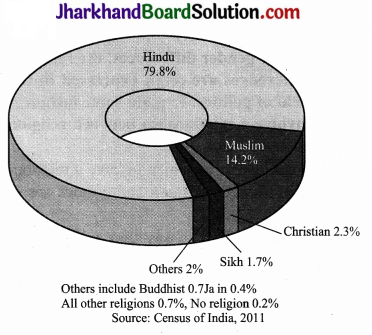
Question 1.
Picture Interpretation Study the pie chart carefully and answer the following questions:
(a) Which religious groups are minority communities in India?
(b) What is the percentage of Jains in India’s total population?
(c) What is the percentage of Christians in India’s total population?
Answer:
(a) Muslim, Sikh, Christian, Buddhist, Jain, etc., are the minority communities of India.
(b) The percentage of Jains in India’s total population is 0.4%.
(c) The percentage of Christians in India’s total population is 2.3%.
